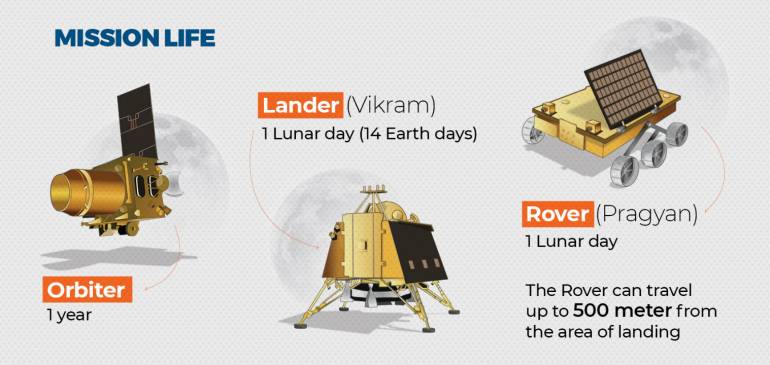Isro's Chandrayaan - 2
 |
| Chandrayaan-2 |
Chandrayaan-2 is an Indian lunar mission to explore the unchartered south pole of the celestial body by landing a rover.
On September 7, India attempted to make a soft landing on to the lunar surface.
However, lander Vikram missed the primary landing site and went for the second. The visuals went missing henceforth.
According to Isro chief K Sivan, communication from Vikram lander was lost and data is still being analysed.
If India does succeed, it will be the fourth country to land on the moon, after the erstwhile USSR, US and China, to cement its place among the world's space-faring nations.
India's Geosynchronous Satellite Launch Vehicle, GSLV MkIII-M1 had successfully launched the 3,840-kg Chandrayaan-2 spacecraft into the earth's orbit on July 22.
Chandrayaan-2 satellite had begun its journey towards the moon leaving the earth's orbit in the dark hours on August 14, after a crucial maneuver called Trans Lunar Insertion (TLI) that was carried out by Isro to place the spacecraft on "Lunar Transfer Trajectory".
In a major milestone for India's second Moon mission, the Chandrayaan-2 spacecraft had successfully entered the lunar orbit on August 20 by performing Lunar Orbit Insertion (LOI) maneuver. On August 22, Isro released the first image of the moon captured by Chandrayaan-2. On September 2, 'Vikram' successfully separated from the orbiter, following which two de-orbiting manoeuvres were performed to bring the lander closer to the Moon.
'Vikram' and 'Pragyan'
As India attempted a soft landing on the lunar surface on September 7, all eyes were on the lander 'Vikram' and rover 'Pragyan'.
The 1,471-kg 'Vikram', named after Vikram Sarabhai, father of the Indian space programme, was designed to execute a soft landing on the lunar surface, and to function for one lunar day, which is equivalent to about 14 earth days.
Chandrayaan-2's 27-kg robotic vehicle 'Pragyan', which translates to 'wisdom' in Sanskrit, can travel up to 500 metres from the landing spot on the moon and leverages solar energy for its functioning.
If successful, Pragyaan will roll out from inside the lander to carry out an intense probe of the moon soil with its two payloads.
Chandrayaan, which means “moon vehicle” in Sanskrit, exemplifies the resurgence of international interest in space. The US, China and private corporations are among those racing to explore everything from resource mining to extraterrestrial colonies on the moon and even Mars.
Isro's future plans
Isro’s next priority is the $1.4 billion Gaganyaan mission, which aims to put three Indian “gaganauts” — at least one of which will be a woman — into orbit.

Why are we going to the Moon?
The Moon is the closest cosmic body at which space discovery can be attempted and documented. It is also a promising test bed to demonstrate technologies required for deep-space missions. Chandrayaan 2 attempts to foster a new age of discovery, increase our understanding of space, stimulate the advancement of technology, promote global alliances, and inspire a future generation of explorers and scientists.
What are the scientific objectives of Chandrayaan 2?Why explore the Lunar South Pole?
Moon provides the best linkage to Earth’s early history. It offers an undisturbed historical record of the inner Solar system environment. Though there are a few mature models, the origin of Moon still needs further explanations. Extensive mapping of lunar surface to study variations in lunar surface composition is essential to trace back the origin and evolution of the Moon. Evidence for water molecules discovered by Chandrayaan-1, requires further studies on the extent of water molecule distribution on the surface, below the surface and in the tenuous lunar exosphere to address the origin of water on Moon.
The lunar South Pole is especially interesting because of the lunar surface area here that remains in shadow is much larger than that at the North Pole. There is a possibility of the presence of water in permanently shadowed areas around it. In addition, South Pole region has craters that are cold traps and contain a fossil record of the early Solar System.
Chandrayaan-2 will attempt to soft land the lander -Vikram and rover- Pragyan in a high plain between two craters, Manzinus C and Simpelius N, at a latitude of about 70° south.
No comments:
Post a Comment